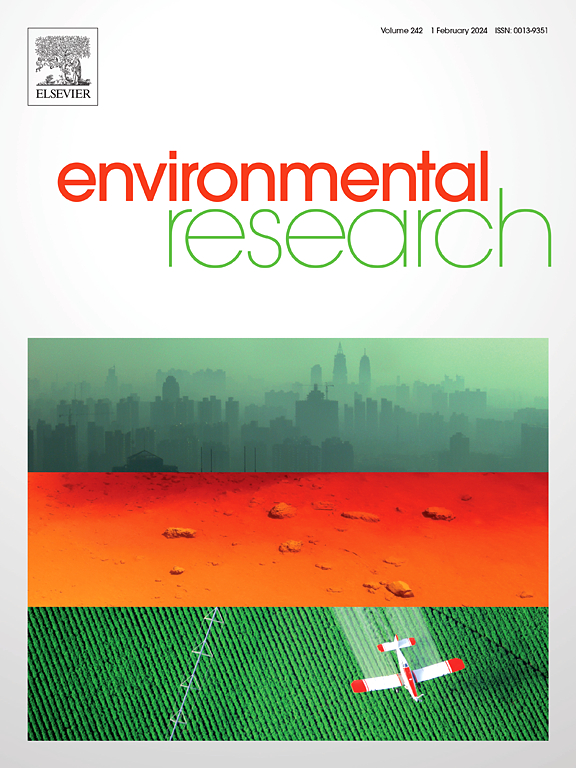Early life phthalate exposure impacts gray matter and white matter volume in infants and young children
IF 7.7
2区 环境科学与生态学
Q1 ENVIRONMENTAL SCIENCES
引用次数: 0
Abstract
Objective
Prenatal phthalate exposure is associated with adverse neurodevelopmental outcomes, yet data on impacts of early life exposure remains limited. We investigated phthalate and replacement plasticizer exposures from 2 weeks to 7 years of age in relation to brain anatomical attributes, using serial structural magnetic resonance imaging (sMRI).
Material and methods
Children were enrolled after birth into the UNC Baby Connectome Project, a longitudinal neuroimaging study (North Carolina, USA; 2017–2020). Urine samples (n = 406) were collected at each visit and analyzed for 17 phthalate and replacement plasticizer metabolites. Among 157 children contributing 369 sMRIs, we calculated metabolite-specific average exposures across each individual's urine samples and used linear mixed models to estimate longitudinal associations of log transformed, specific gravity-adjusted average metabolite concentrations with gray and white matter volume, and cortical volume, thickness, and surface area. We examined sex-specific differences in these associations.
Results
Higher average metabolite concentration was associated with lower gray matter volume (MCPP: (−1.73 cm3, 95 % CI: −3.36, −0.10) and higher white matter volume (∑DEHP: 2.28 cm3, 95 % CI: 0.08, 4.48). Among boys (n = 72, 140 sMRIs), MEP (−2.97 cm3, 95 % CI: −5.85, −0.09) and MiBP (−2.40 cm3, 95 % CI: −4.64, −0.15) were also associated with lower gray matter volume. Among females (n = 85, 229 MRIs), higher ∑DINCH exposure was associated with higher white matter volume (2.27 cm3, 95 % CI: 0.29, 4.25). We observed significant sex interactions for ∑DEHP with gray matter (p-interaction = 0.03) and ∑DINCH with white matter volume (p-interaction = 0.001).
Conclusion
Early life phthalate/plasticizer exposure may differentially impact various brain region volumes in early childhood, with potential downstream consequences on functional development.
早期接触邻苯二甲酸盐会影响婴幼儿的灰质和白质体积。
目的:产前邻苯二甲酸盐暴露与不良的神经发育结果相关,但关于早期生活暴露影响的数据仍然有限。我们使用连续结构磁共振成像(sMRI)研究了从2周至7岁邻苯二甲酸盐和替代增塑剂暴露与大脑解剖属性的关系。材料和方法:出生后的儿童被纳入UNC婴儿连接体项目,这是一项纵向神经影像学研究(North Carolina, USA;2017 - 2020)。每次就诊时收集尿液样本(n=406),分析17种邻苯二甲酸盐和替代增塑剂代谢物。在157名有369个sMRIs的儿童中,我们计算了每个人尿液样本中代谢物的特定平均暴露量,并使用线性混合模型来估计对数转换、比重调整的平均代谢物浓度与灰质和白质体积、皮质体积、厚度和表面积的纵向关联。我们研究了这些关联的性别差异。结果:较高的平均代谢物浓度与较低的灰质体积(MCPP: -1.73 cm3, 95% CI: -3.36, -0.10)和较高的白质体积(∑DEHP: 2.28 cm3, 95% CI: 0.08, 4.48)相关。在男孩中(n=72, 140名sMRIs), MEP (-2.97 cm3, 95% CI: -5.85, -0.09)和MiBP (-2.40 cm3, 95% CI: -4.64, -0.15)也与较低的灰质体积有关。在女性中(n=85, 229),较高的∑DINCH暴露与较高的白质体积相关(2.27 cm3, 95% CI: 0.29, 4.25)。我们观察到∑DEHP与灰质(p-互作=0.03)和∑DINCH与白质体积(p-互作=0.001)的显著性交互作用。结论:早期接触邻苯二甲酸盐/增塑剂可能会对儿童早期不同脑区容量产生不同的影响,并可能对功能发育产生潜在的下游影响。
本文章由计算机程序翻译,如有差异,请以英文原文为准。
求助全文
约1分钟内获得全文
求助全文
来源期刊

Environmental Research
环境科学-公共卫生、环境卫生与职业卫生
CiteScore
12.60
自引率
8.40%
发文量
2480
审稿时长
4.7 months
期刊介绍:
The Environmental Research journal presents a broad range of interdisciplinary research, focused on addressing worldwide environmental concerns and featuring innovative findings. Our publication strives to explore relevant anthropogenic issues across various environmental sectors, showcasing practical applications in real-life settings.
 求助内容:
求助内容: 应助结果提醒方式:
应助结果提醒方式:


